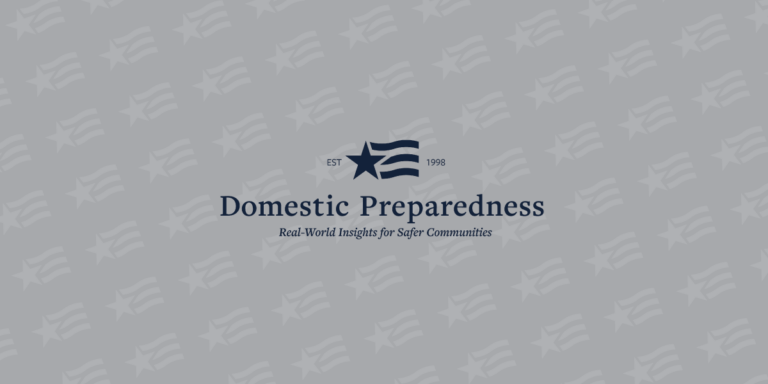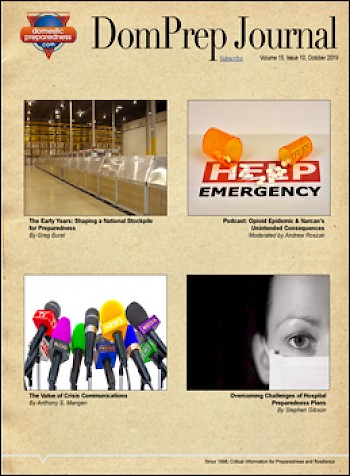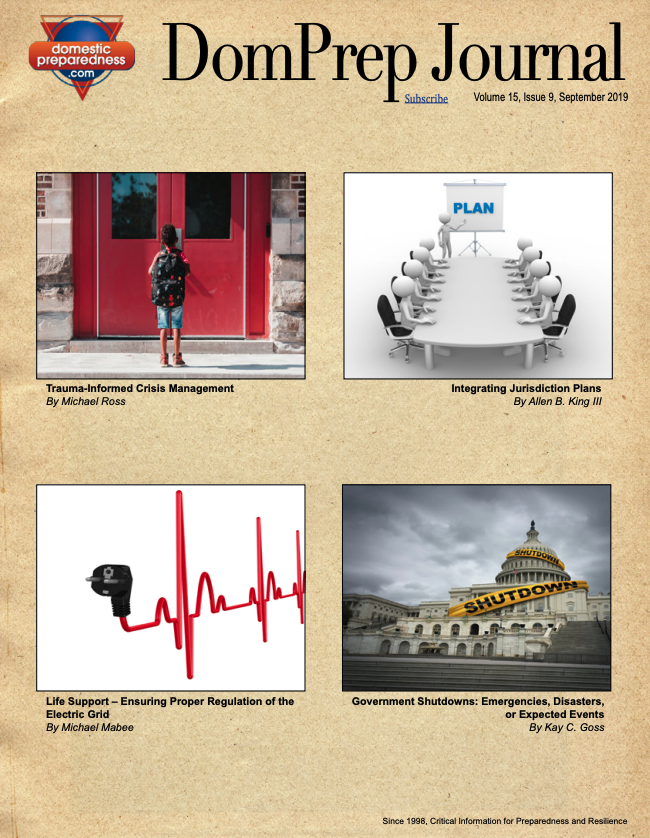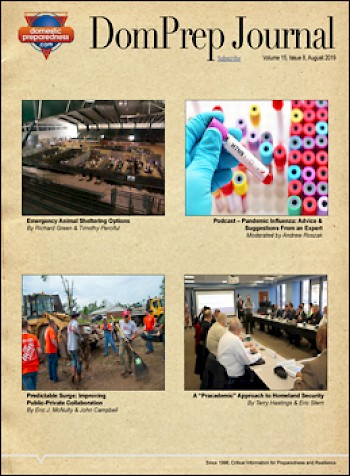
Author Archive

This report provides an overview of the Disaster Recovery Reform Act (DRRA), highlights its alignment with the Federal Emergency Management Agency’s (FEMA) strategic goals, and describes FEMA’s efforts to implement the law. https://www.fema.gov/media-library-data/1573222648380-b2fc54c82eb3b03c0724cbc696a94613/DRRAAnnualReport_FINAL_PUBLISHED.pdf

October 2019
Domestic Preparedness
October 30, 2019
Featured in this issue: Overcoming Healthcare Challenges & Finding Solutions, By Catherine L. Feinman; The Early Years: Shaping a National Stockpile for Preparedness, By Greg Burel; Podcast: Opioid Epidemic & Narcan’s Unintended Consequences, Moderated by Andrew Roszak; The Value of Crisis Communications, By Anthony S. Mangeri; Overcoming Challenges of Hospital

Pre-Disaster Recovery Planning Guide for Tribal Governments
Domestic Preparedness
October 9, 2019
The Pre-Disaster Recovery Planning Guide for Tribal Governments is designed to prepare tribal governments for recovery efforts from future disasters by engaging with the whole community and planning for recovery activities that are comprehensive and long term. The guide also provides tools for public engagement and for identifying existing recovery

September 2019
Domestic Preparedness
September 30, 2019
Featured in this issue: Preparing a Nation for Disaster – One Community at a Time, By Catherine L. Feinman; Trauma-Informed Crisis Management, By Michael Ross; Integrating Jurisdiction Plans, By Allen B. King III; Life Support – Ensuring Proper Regulation of the Electric Grid, By Michael Mabee; Government Shutdowns: Emergencies, Disasters,

HHS Should Address Deficiencies Highlighted by Recent Hurricanes in the U.S. Virgin Islands and Puerto Rico
Domestic Preparedness
September 30, 2019
The U.S. Government Accountability Office (GAO) was asked to review the federal public health and medical services response to Hurricanes Irma and Maria in the U.S. Virgin Islands and Puerto Rico. The report examines the U.S. Department of Health and Human Services’ (HHS) actions and leadership of this response. Following

WMD Capabilities Enabled by Additive Manufacturing
Domestic Preparedness
September 17, 2019
This report highlights recent developments in Additive Manufacturing (AM) relevant to nuclear proliferation and adds analyses of the impact of AM on delivery systems as well as chemical and biological weapons programs. Focusing on AM developments in both North America and Western Europe, this report maps latest AM developments, projects

Disasters and People With Serious Mental Illness
Domestic Preparedness
September 9, 2019
This bulletin focuses on the experiences of individuals with serious mental illness (SMI) before, during, and after disasters. Research focused on individuals with schizophrenia, bipolar disorder, major depression, and post-traumatic stress disorder (PTSD), and on individuals with SMI as defined in part through functional limitations. https://www.samhsa.gov/sites/default/files/disasters-people-with-serious-mental-illness.pdf

Cybersecurity and Infrastructure Security Agency Strategic Intent
Domestic Preparedness
August 30, 2019
Meeting their constitutional duties to provide for the common defense, the U.S. Congress and the Administration established the Cybersecurity and Infrastructure Security Agency (CISA) to lead the national effort to protect our critical infrastructure. This document is the keystone of this new agency. https://www.dhs.gov/sites/default/files/publications/cisa_strategic_intent_s508c_0.pdf

August 2019
Domestic Preparedness
August 28, 2019
Featured in this issue: Don’t Procrastinate – Collaborate, By Catherine L. Feinman; Emergency Animal Sheltering Options, By Richard Green & Timothy Perciful; Podcast – Pandemic Influenza: Advice & Suggestions From an Expert, Moderated by Andrew Roszak; Predictable Surge: Improving Public-Private Collaboration, By Eric J. McNulty & John Campbell; A “Pracademic”

Planning Considerations: Evacuation and Shelter-in-Place – Guidance for State, Local, Tribal and Territorial Partners
Domestic Preparedness
August 12, 2019
Evacuation and shelter-in-place protective actions are prompted by a variety of threats and hazards. Incident-specific circumstances drive the relevant protective actions based on a community’s demographics, infrastructure, resources, authorities, and decision-making process. Determining that an evacuation needs to take place is not an all-or-nothing approach. Lessons learned from disasters, such
Follow Us
Get Instant Access
Subscribe today to Domestic Preparedness and get real-world insights for safer communities.
ARchives
Article Out Loud – How Technology Systems Impact Critical Infrastructure
December 21, 2022
Operational technology systems that run many critical infrastructure functions are becoming more dependent on information technology. As these worlds converge, emergency preparedness professionals must address the related security challenges. This article shares some lessons learned and uses a foundational knowledge of the topic to inspire possible solutions.
Article Out Loud – The Importance of Strong Leadership for a Unique Discipline
December 21, 2022
A transformational leadership style can help bridge relationship and communication gaps between leaders and other community stakeholders. Learn how one young deputy fire chief learned from his past leadership missteps and honed his meta-leadership skills, which were essential in reconnecting communities when he became a state emergency manager.
Article Out Loud – Applying Environmental Design to Prevent Active Shooters
December 14, 2022
Active shooter trainings can help prevent some injuries and deaths. However, additional measures should also be taken to prevent the attack from occurring. This article describes how to apply environmental design to thwart attackers.
Article Out Loud – Implementing “Stop the Bleed” for Future K-12 Educators
December 14, 2022
How have recent school shootings impacted future K-12 educators and what new skills will help better prepare them for potential threats? One study at the University of North Alabama combined training and research to answer this question.
Article Out Loud – Operation Twister – Exercising Disaster Behavioral Response
December 13, 2022
Functional exercises are invaluable for helping participants understand their roles in disasters. This is particularly true for participants who normally are not included in interagency exercises, such as behavioral health personnel. Triaging following a disaster should not stop at the physical level, but should consider psychological concerns as well.
Article Out Loud – Public Health Answers for Non-Public Health Organizations
December 13, 2022
Public health is a concern for all citizens, but the preparedness efforts for public health emergencies provide information primarily to that sector. Members of the private sector and/or other “non-public health organizations” should take the additional steps needed to help ensure that continuity of operations plans are in place before
Article Out Loud – Value of Enterprise Data Management in Emergency Management
December 7, 2022
An enterprise data management program emphasizes the importance of managing information as an asset and protecting it from misuse or loss. Knowing the landscape of data and how to manage it is critical to an organization’s recovery and sustainability after a disaster. This article explains the need to coordinate data
Article Out Loud – Maintaining a Strong Volunteer Force
December 7, 2022
Volunteers are a lifeline for many nonprofit organizations and for-profit companies during emergencies and disasters. However, recruiting and retaining good volunteers can be difficult. This article shares some simple strategies and tools for any emergency preparedness professional seeking to build and maintain a strong volunteer force.
Article Out Loud – Listeria – When Food Bites Back
December 6, 2022
According to the Centers for Disease Control and Prevention, one in six Americans suffer from food poisoning each year; most of those cases are attributed to familiar pathogens like Salmonella. However, the deadliest U.S. foodborne disease outbreak in nearly a century was caused by a lesser known, but much more
Article Out Loud – Incident Response for Nursing & Assisted Living Homes
December 6, 2022
The adaptability of the Incident Command System makes it a valuable tool for a variety of agencies and organizations. During fire incidents, for example, fatality rates at healthcare facilities such as nursing and assisted living homes could be reduced if proper procedures are in place for managing the special needs
Follow Us
Get Instant Access
Subscribe today to Domestic Preparedness and get real-world insights for safer communities.


